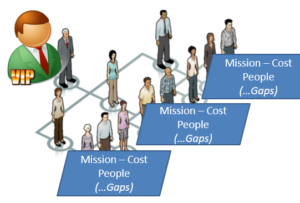How are Deals lost? – Customers make Plans (Part 1)

Customers do have a Plan (woops, sorry, you are not in the plan…)
If you do have “stalled deals” in your Pipeline, you perhaps also have a collection of “reasons why deals are stalled”. You may also sense that some deals are on a pathway from “stalled deal” to “lost deal”. Now consider the customer perspective. Pretend that you are a senior decision-maker looking at a vendor proposal. How do you decide to accept or decline?
The key issues will include: What is the business need, and its priority? What is the funding cost and justification? Does it support existing initiatives? Does it have consensus support among affected team members? Who will implement? Who will use it? Why now, why not later?
Sales people may believe a proposal will be won by achieving something for the customer, but the real buying drivers are often more subtle – e.g. how will this help us achieve our current plan? So the questions we ask need to drive out full understanding of the current plan. The line of reasoning has to be expressed, and usually we do have a “Champion” ready to work on that. The Champion may see this as their job, not a vendor’s job – so they work on it, and they work hard. Eventually they arrive at a tough fork in the road – they are getting more opposition than support, while the vendor is on the outside unaware of the delay reasons, which often have a unique complexity. Frankly, I would rather be in a chair beside the Champion when an obstacle emerges!
Customers take off ramps – can we?
When an approval obstacle arrives, a deal becomes stalled. However we do not know about it, or how to repair it. If I do find out about an obstacle, I like to ask myself “Is this an indicator that the deal will die? Or is there a way to salvage it?” The odd thing is that customers, especially Champions, do not want us to give up when this kind of an issue arrives in the early days. Later, after they have had a few battles for approval, they may get discouraged, and accept a non-approval. My point is, it works better to challenge a buyer at the outset, saying “this deal cannot be sold”. They will then be open to discussing potential obstacles, and indeed sharing ALL internal information necessary to understand why a deal may be approved or refused. And they will do several important things:
- Provide a full explanation of the current business plan and what are the many things already in management focus, and already approved for spending
- Lean towards a close collaboration on building the business case for your expected proposal
- Be ready to provide introduction to other managers so you can gather first-hand information and personal priorities
- In some cases, say YES when asked to collaborate on creating an internal proposal
In a nutshell, by suggesting a vendor off ramp we end up getting agreement that we can work closely together, and off ramps may be taken by either party – with a preference that off ramps be taken based on stage progress.
Insiders identify barriers – can we become an Insider?
So, how do we get inside the Plan? – Good question, and there are multiple pathways to an effective “plan entry”. One audacious approach is to “just ask” – i.e. “Mr. Customer, may I help you prepare an internal proposal?” That usually gets a smile, and agreement more often than not. If no agreement, you will at least get some hard info on how the deal may be won, lost or stalled. The question needs to be framed by how you approach it, and your timing. More in the chapters to follow. Also, a fascinating deeper dive in our webinars



Follow Us
Follow us on LinkedIn for updates.